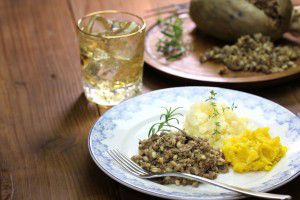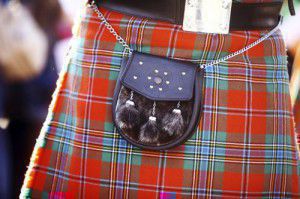Happy Burns Night!
 ‘Some hae meat and canna eat,
‘Some hae meat and canna eat,
And some wad eat that want it;
But we hae meat and we can eat,
Sae the Lord be thankit!’
It’s January 25th, the night that no haggis is safe! Lock up your neeps and tatties, and hide the good whisky. The hungry hordes are on the way!
In my family, Burns Night has always been an annual tradition, with my Nan hosting the festivities and always inviting a few new (and unsuspecting) guests each year. Now that she’s gone, I host my own Burns Nights, and always stick to her menu of a cullen skink starter, haggis, neeps and tatties, and cranachan for dessert. Never having been to a Burns Night outside my family, I’ve always suspected that we might do things a bit differently to everyone else, but then that’s part of the appeal: as long as you include a few essential components, every host will have their own twist on the rest of the night.
The elements that can’t be forgotten, in my book, are the piping in of the haggis – although, as nobody I know has any bagpipes, we tend to use whatever musical instrument is closest to hand, including the tin whistle, violin and, perhaps most successfully, the harmonica. The Address to a Haggis has to be delivered by the host, who will stab it as theatrically as they can when they reach the line ‘His knife see rustic labour dight / An cut you up wi ready slight,’ and ideally a spewing out of the haggis’ delicious-smelling ‘gushing entrails bright’ sees an end to any misgivings the guests had about trying their first haggis. (Little side note – if you haven’t ever had haggis before, go and buy one immediately: it’s the one thing that makes me seriously question my commitment to vegetarianism).
In my house, we then tend to relax a bit while everyone gets their teeth into the haggis, but at the arrival of the seriously creamy, very alcoholic cranachan (lots of oats, lots and lots of whisky, lots of cream, with a few raspberries interlaced), some unsuspecting guest will usually be asked to honour Rabbie Burns by reading a poem. Ideally somebody English is chosen so that the attempt to read fluent Scots has maximum effect. My favourite surprise poem to launch on guests is ‘A Man’s A Man For A’ That’, but ‘To A Mouse’ does the trick as well: by the time they get to the line ‘To thole the winter’s sleety dribble, An’ cranreuch cauld!’, all social boundaries tend to have broken down and everyone’s the best of friends.
After that, it’s just a case of more whisky, more whisky and more whisky still, until the wee hours see everyone singing and dancing arm-in-arm around (and occasionally on) the kitchen table.
Guid health!
Nat
Languages of the week: Scotland
This week we’re celebrating Scotland, in honour of the Braemar Gathering of the Scottish Highland Games, which took place this weekend.
 The Braemar Gathering is one of many events that make up the Highland Games from May to September each year. It’s attended by 16,000 people, including members of the Royal Family. Events include tossing the caber, putting the stone, Highland dancing and piping, and competitors must dress in Highland costumes.
The Braemar Gathering is one of many events that make up the Highland Games from May to September each year. It’s attended by 16,000 people, including members of the Royal Family. Events include tossing the caber, putting the stone, Highland dancing and piping, and competitors must dress in Highland costumes.
Scotland has three languages: Scottish Gaelic, Scots and Scottish English – all of which you can now learn with uTalk.
Scottish Gaelic
The Scottish Gaelic alphabet has 18 letters, each of which is named after a tree or shrub.
It’s spoken by 60,000 people, mainly in the Highlands and the Western Isles, but also in Glasgow, Edinburgh and Inverness.
There are also small Gaelic speaking communities in Canada, particularly in Alba Nuadh and on the Cape Breton Islands.
Scottish Gaelic was seen as a declining language, but recently there’s been a real resurgence in schools and an increased presence in the media. The BBC operates a Gaelic language radio station, Radio nan Gàidheal.
Scots
Scots is spoken in the Lowlands and Northern Isles of Scotland. It has four dialects: Insular Scots, Northern Scots, Central Scots and Southern Scots.
A Germanic language variety, Scots is influenced by Gaelic, Norse, Latin, Dutch, Norman French, Standard French and English.
The poet Robert Burns wrote in Scots; a well-known example is Auld Lang Syne, which was written in 1788 and is now traditionally sung at New Year.
So here’s your Challenge of the Week – we want to hear you singing (or reciting, if singing’s not your thing) Auld Lang Syne in the original Scots. If you’re not sure of the words, the BBC website can help. Send us your videos on Twitter to @EuroTalk with hashtag #1788Scots
Scottish English
Also known as SSE (Standard Scottish English), Scottish English dates back to the 17th century, when Scots and English combined.
Although an English speaker can understand Scottish English, the language contains a lot of different words. Some examples are: ‘poke’, which in Scottish English is a container for chips, ‘ken’, which means ‘know’, and ‘aye’, which is the Scottish way of saying ‘yes’.
A few fun facts about Scotland
The national animal of Scotland is the unicorn.
The shortest scheduled flight in the world is from Westray to Papa Westray in the Orkney Islands of Scotland. At just one and a half miles long, it only takes 1 minute 14 seconds.
Scotland’s traditional dish, haggis, consists of the heart, liver and lungs of a sheep boiled in its stomach. It’s tastier than it sounds!
The first recorded sighting of the Loch Ness Monster was in 565 AD, when a ‘water beast attacked one of St Columba’s followers in the loch’.
What’s your favourite Scotland fact?
